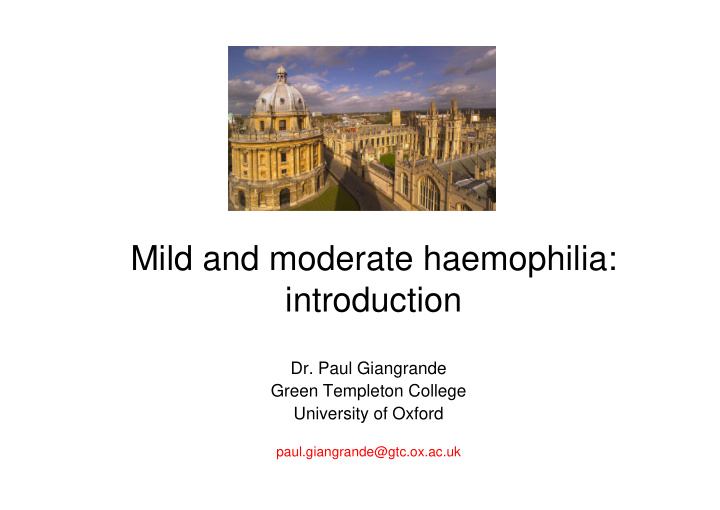



Mild and moderate haemophilia: introduction Dr. Paul Giangrande Green Templeton College University of Oxford paul.giangrande@gtc.ox.ac.uk
ISTH definitions: White GC et al. Thromb. Haemost. 85: 560 (2001) Categories defined by factor VIII/IX level: • Severe haemophilia: < 1% (0.01 IU/ml) • Moderate haemophilia: 1-5% • Mild haemophilia: > 5% - < 40% The term “nonsevere” is increasingly being used in clinical studies to include both patients with mild and moderately severe haemophilia
den Uijl IEM et al. Haemophilia 17: 849-853 (2011)
den Uijl IEM et al. Haemophilia 17: 849-853 (2011)
Challenges of nonsevere haemophilia: • Far more nonsevere than severe patients • Diagnosis often delayed • Patients generally far less engaged with specialist haemophilia centres • Danger of complacency: risk of bleeding underestimated by patients and doctors • Not trained to self-infuse concentrates • Some of these patients develop inhibitors – Dramatic impact on bleeding pattern
Sports-related injuries in mild haemophilia:
One stage clotting Chromogenic Patient sample • Factor deficient plasma • Purified proteins Method aPTT reagent & Ca ++ Ca ++ • • • Fibrin formation • FXa generation Goal Metric • Turbidity • Colorimetric
Relevance to diagnosis: • Significant discrepancy between results of one stage and two stage/chromogenic FVIII assays in large proportion of patients with mild and moderate haemophilia Poulsen Al et al. Haemophilia 15: 285-289 (2009) • One stage result may be normal whilst two stage/chromogenic assay result is low • Bleeding tendency correlates best with lower two stage/chromogenic result • No discrepancy in severe haemophilia
Relevance to diagnosis: • Some reports of reverse discrepancy (low one stage/normal chromogenic) but these patients generally have no bleeding symptoms • If you only use a one stage assay: – Some cases of mild haemophilia will be missed – Some patients with moderate haemophilia will be incorrectly labelled as mild – Some normal subjects will be incorrectly labelled as having a bleeding disorder
Potgieter JJ et al. Eur J Haematology 94 (Suppl. 77): 38-44 (2015)
Type 2N VWD: • Often mistaken for mild haemophilia A • Defect is in N-terminal of VWF: factor VIII binding to VWF is impaired • Three mutations in exons 18-20 account for ≈ 95% of cases: T791M, R816W, R854Q • Factor VIII typically in range 3-15 iu/dl (%) • VWF levels all normal (Ag/RCo/CB) • Bleeding time is normal • Autosomal recessive inheritance: both sexes affected in family tree • DNA-based studies will confirm diagnosis • FVIII binding assay an alternative test
Lancet 309: 869-872 (1977)
DDAVP: what is new? • Response improves with age Revel-Vilk S et al. Br J Haematol 117: 847-951 (2002) • Response dependent on F8 mutation Stoof SCM et al. Thromb Haemostas 109: 440-449 (2013) – Poor response with R2169H and P149R • Lower absolute increase in factor VIII level observed in patients with blood group O Mauser-Bunschoten EP et al. J Thromb Haemostas 11: 2179-2181 (2013) • Safe to use during pregnancy in carriers Trigg DE et al. Haemophilia 18: 25-33 (2012) • May be of therapeutic benefit in some cases of type 2 VWD (not just type 1)
Inhibitor development in nonsevere haemophilia: Eckhardt C and INSIGHT Study Group. Blood 122: 1954-1962 (2013) • 1112 nonsevere haemophilia A patients from 14 centres in Europe and Australia that had genotyped ≥ 70% of their patients • During 44,800 exposure days (median, 24 per patient), 59 of the 1112 patients developed an inhibitor: – Cumulative incidence of 5.3% – After a median of 28 exposure days
Inhibitor development in nonsevere haemophilia: Eckhardt C and INSIGHT Study Group. Blood 122: 1954-1962 (2013) • The inhibitor risk after 50 exposure days was 6.7% (95% CI, 4.5-8.9) • The risk increased to 13.3% after 100 exposure days (95% CI, 9.6-17.0) • Among a total of 214 different F8 missense mutations, 19 were associated with inhibitor development • These results emphasize the importance of F8 genotyping in nonsevere hemophilia
Outcome and eradication strategies: van Velzen A and INSIGHT Study Group. Thromb Haemostas 114: 46-55 (2015) • 101 inhibitor patients from a source population of 2,709 nonsevere HA patients – Median age 37 years; median peak titre 7 BU/ml • Inhibitor disappeared in 72/101 (71%) – Spontaneously 51/73 (70%) – After eradication treatment 21/28 (75%) • Eradication strategies varied widely – Conventional immune tolerance induction and immunosuppression
Outcome and eradication strategies: van Velzen A and INSIGHT Study Group. Thromb Haemostas 114: 46-55 (2015) • Anamnestic response seen after rechallenge in 25/72 (35%) of patients who lost antibodies – Disappearance does not always equal sustained response • Sustained success was observed in 64 % (30/47) of patients rechallenged • In high-titre inhibitor patients, eradication treatment was associated with sustained success (RR 2.3)
Principal conclusions: • Need to improve engagement of nonsevere patients with treatment centres • Patients and health care professionals often underestimate potential for bleeding – Bleeds caused by sporting injuries can be severe • Response to DDAVP linked to F8 mutations • Patients can develop inhibitors after treatment with coagulation factor concentrates • Chromogenic assay best for reliable diagnosis • Always exclude possibility of 2N VWD
Recommend
More recommend